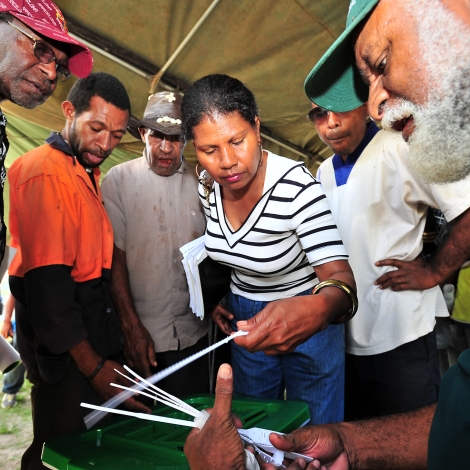This post is part of a three-part series that explores the power of new information technologies, in particular cryptography, to profoundly benefit humanity, creating new ways for social and economic institutions to function. Concepts presented here arose through informal research performed by the author under the guidance of Dr. Joseph Hughes, Founding Director of the Peace Engineering Program at Drexel University in Philadelphia, Pennsylvania (USA). This information also formed part of a masters certificate program at the Mortenson Center in Global Engineering at the University of Colorado Boulder.
- Cryptographic Institutions Part One: Humanitarian Identity – the first post focuses on individuals and the extreme context of forced displacement.
- Cryptographic Institutions Part Two: Equitable Markets – the second post focuses on market activity.
- This third post focuses on systems of governance and collective action, and also addresses practical barriers and risks for all three posts.
Collective action and governance can make our societies more peaceful, just, equitable, and compassionate. However, systems of bureaucracy, regulation, and controlled distribution can be plagued by inefficiency and corruption. Too often, poorly structured institutions cause more harm than good. The efficiency and equity of collective action depends greatly on the information systems used. The information automata we have discussed previously could revolutionize systems of governance and collective action as well as individual identity and market activity. This post explores concrete applications.
Definitions and summaries of enabling information technology:
Access to computation and data connectivity is broadening around the world. Artificial intelligence (AI) and the Internet of things (IOT) sensing is making objective and high-frequency data much cheaper to produce. Examples include fingerprint scanners, drone surveying, GPS, new water quality sensors, etc.
Distributed databases (blockchains) automate the authenticity of information. Applications include bank accounts, citizenship, land titles, professional certifications, etc.
Zero-knowledge proofs (ZKP) automatically and digitally resolve privacy and verification. Information can be authenticated, without any details of the information being divulged. Proving citizenship without divulging identity, for example.
Secure multiparty computation (SMC) calculates results from a large dataset without knowing any of the individual data points. An example would be medical research on large medical datasets while preserving the privacy of the people and organizations that contributed the medical data)
For a more in-depth overview, see this series on appreciating cryptosystems.
Voting
Effective voting that resists fraud and corruption requires verifying voter identity and also creating ballot anonymity. Currently, physical walls and identity documents create ballot authenticity. Then, mixing large numbers of anonymous ballots creates privacy. However, administrators’ operational decisions affect access to voting stations and bias voter turn-out. One example is the physical ID. Since physical IDs can be forged, administrators may become concerned with voter fraud and justify excessive identification requirements. Those can lead to the disenfranchisement of some voters, given the inequitable access to identification. Another example is the vote count. The collection and counting of manual votes creates endless opportunity for error, lost ballots, and ballot disqualification.
Digital identity would make voting easier and more reliable. It would also enable voting over the Internet (e-voting) which would reduce strategic biasing of voter turnout. Blockchain-based voting could provide these benefits and add the benefit of ZKP and SMC. Utilizing ZKP and/or SMC in an advanced crypto-information system could make the authentication, collection and counting of every digital vote transparent and traceable, while still maintaining voter anonymity. It would also be much less expensive to operate than physical security and voting stations.
With such efficient voting, many decisions could be moved closer to direct representation, and we could easily try out advanced voting methods like scored voting. For example, instead of a corruptible bureaucracy deciding to sell or lease public land (to agriculture, housing development, oil and gas, etc.), the sale could go directly through the public. In this example, county residents could decide the price at which they are willing to have a local lake surrounded by a new housing development. This form of governance could better combine the benefits of collective ownership with market influences.
Distribution and Collection
Collective action often involves the accurate distribution or collection of physical goods, services, and money. Vaccines, food stamps and disaster assistance (food, water, shelter, medical aid) must be distributed fairly and efficiently. Tracking in-kind distribution with crypto-identities would be far easier, more transparent and accurate. Money for stimulus checks, insurance and medical care, unemployment insurance, rent assistance, taxes, tolls, fees, tax returns and negative tax brackets/UBI would also be much faster with crypto-identities interoperable with bank accounts.
Determining what different people deserve and qualify for is even harder than the actual distribution/collection. With complete and automated crypto-identities linking the various aspects of a person’s life (employment, finances, medical records, property ownership), qualification decisions would be better informed, more transparent, likely fairer, and even partially automated. New crypto technologies like ZKP could keep all this information private and anonymous, even from the government, along with the increased accuracy and transparency.
Service Delivery, Utilities, and Maintenance

Ibrahim Youssif Adam at the Sudanese Ministry of Irrigation monitors the water level in a pump in the Abu Shouk camp for Internally Displaced Persons in North Darfur in 2013. Pump monitoring technology could be upgraded with crypto-information systems to alert technicians of problems as they occur. Photo: Albert González Farran – UN African Union Mission in Darfur (UNAMID) (CC BY-NC-ND 2.0)
Service delivery benefits from information automata in the same way as physical and monetary collection and distribution. But services also require operation and maintenance. Consider the WASH industry.
Around one-quarter to one-third of humanity still doesn’t have access to safe drinking water. The naive approach to the global rural water supply has been to build boreholes with manual pumps and assume they would be used and maintained. That assumption didn’t hold. Next, aid agencies tried setting up community-member committees to collect fees and organize maintenance. This resulted in some beautiful success stories, but overall fell short of expectations. In 2017, the industry standard was to set up a professional repair service that communities could call upon. This still only managed to keep on average 56 percent of boreholes functioning at any given time. That’s barely over half!
Now, the WASH industry is pushing to further improve the institutions, governance, financing and incentive models (pay-for-performance) and integrate IOT monitoring into boreholes. Recent models show anticipatory repair using an AI predictor and borehole IOT sensor data could improve the uptime of boreholes to greater than 99 percent. The physical borehole infrastructure and technology has barely changed since the first approach. The missing piece has been robust management institutions which use sustainable financing methods to incentivize great service, are capable of connecting with supply chains for repair parts and labor, and have reliable monitoring data. This progression has essentially been an evolution towards more capable information systems.
New water bacteria meters could improve the accountability of water quality as well as quantity in grid-based water supply, and water ATMS can provide another method of distributed service. Satellite imagery and UAV surveying can also provide useful data. Similar things can be done to improve sanitation and waste removal services on-grid or distributed with “smart latrines”. The same goes for electricity service with meters and automated microgrids. Structures (bridges and buildings) can be monitored with IOT sensors with transparent data to improve accountability and maintenance, and UAV surveying and other sensors can do the same for road and rail maintenance. In general, utilities and services can be kept more accountable to the actual quality of service using transparent and accessible data from distributed sensors.
Global goals, impact measures and political will
How are global goals, like carbon emissions reductions, going to be implemented? We could use legacy information systems to implement monitoring and accountability for carbon emissions, carbon taxes, global corporate taxes, ozone-depleting fluorocarbons, deforestation, wetlands draining, ocean and fishery management, orbital space management, global hunger and poverty, medical crises, etc. But, if we use automated sensing to feed data into advanced crypto-enhanced databases the results will be much better. As discussed in the previous posts, there is already good reason to bring much of the supply chain and economic transactions into decentralized or interoperable cryptosystems, which would provide even greater insights for things like carbon taxing.
New cryptosystems could avoid problems of privacy vs. transparency, and significantly reduce corruption and number-fixing. The accessibility of the data would make the public better informed, strengthening political will. Major political issues like immigration, crime and gun violence, civil rights and discrimination, and foreign aid would have much better and more accessible data, reducing the prevalence of disagreements over basic facts and misinformation.
Currently, Internet speech platforms like social media have weak verification of the identity or credentials of speakers. This speech is often stuck within the news-feed algorithms of corporate platforms. As discussed in the first post, self-sovereign crypto identities could solve both problems. People’s speech could go under their own identity profile, and they could give various media platforms access to different posts. This would make it easier for new platforms to gain usership and compete, and it would mean people’s speech would be owned and controlled by themselves. It would be possible to speak out with a verified identity or other credentials, but also remain anonymous. This would change the game for grassroots organizing, empowerment, political voice, and collective bargaining.
Currently, professional and educational standards and credentials are authenticated by closed-source “expert” institutions which usually use expensive and manual methods of authentication. Online education like Khan Academy, Coursera, Udemy, and Edx are already broadening access to quality education. But, with self-sovereign identities the information that creates credentials could be owned by the school or person that is being accredited or certified. The crypto-certification would also be permanent, even if the certifying organization goes out of operation. Open-sourcing the supporting documentation for standards and credentials could make credentials more transferable across political and cultural borders, reducing the disadvantage of being born in particular locations.
Realism and Risks
The capabilities of emerging information technology are incredible. But just like the systems that have come before, these new systems will have to be properly implemented. It is doubtful that the governments of China or Iran would willingly implement a non-manipulable crypto-voting system. In many countries officials gain a lot from corruption. Why would these officials implement self-sovereign identity systems and responsible supply chain management when they haven’t implemented honest and effective institutions in the past? Resistance from entrenched interests is always a major hurdle for societal innovation. But there may be some reasons why emerging IT has a greater hope of overcoming self-interest and corruption than previous technologies.
The services provided by authorities are still subject to the fundamental forces of competition and supply-demand. It has been noticed that one of the reasons the Taliban has maintained support is because it has provided some government services better than the original government. During the recent Venezuelan monetary crisis, bitcoin use rose significantly in Venezuela. Even though a cryptocurrency doesn’t have the authority of a major government, if it provides the functions of a currency better than the official currency, it will replace it. El Salvador, for example, recently adopted bitcoin as currency.
Emerging information automata, distributed databases/blockchain, are making it possible for small companies to provide robust society-wide “authority and truth” services. This is going to put a lot of pressure on existing institutions to either adopt these same improved practices, or be replaced. Unfortunately, this could lead to major unrest if fundamental institutions go through power struggles between established and new organizations.
Computer science applications rely heavily on pre-built libraries and functionality. It will be important for these new technologies to have a reliable and mature knowledge infrastructure. It will be very easy for organizations to claim they have implemented secure and incorruptible systems even when they built backdoors that allow people in power to manipulate things.
Problems of secure data management won’t entirely go away either. ZKP enables truly passwordless authentication, and decentralized databases are generally more compartmentalized and secure to data hacks. Still, if massive unified digital systems of identity and authority are improperly implemented, privacy leaks and identity theft occurrences could have wider-reaching consequences than they do now.
In the end, it’s up to us
Some of the technologies discussed in this blog series are still emerging, and won’t be ready for use in critical applications for another 5-10 years. But, much of it is ready. Creating unified global systems will likely take a long time and massive effort, but there are targeted and regional applications that could be built now. In the end, how emerging technologies get used is up to us, and we have to imagine it before we can make it a reality.
About the Author
Tejovan Parker completed his professional masters in mechanical engineering from the University of Colorado Boulder in May 2020, focusing on controls and system modelling. He also completed a masters certificate with the Mortenson Center in Global Engineering, and was an intern working on a market systems resilience indicator at iDE. He is a Colorado native. Now he wishes to pursue a PhD in computer science or related field and apply it to global engineering.

